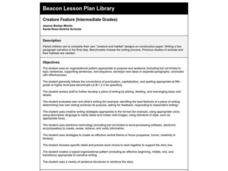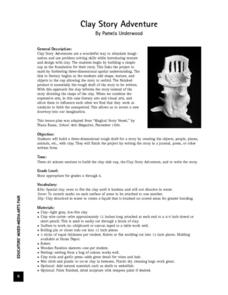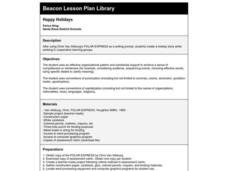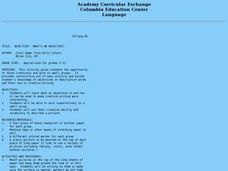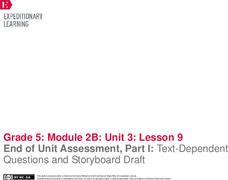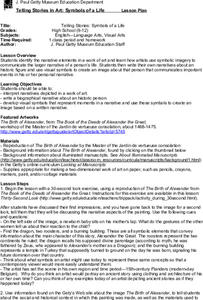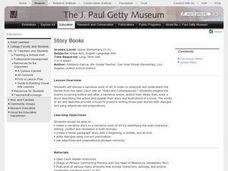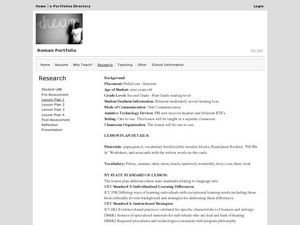Curated OER
Writing a Fictional Narrative
Fourth graders write a fictional narrative using the computer. They can use files to help them focus on including a beginning, middle and end, characters, setting and plot or planning a story by answering questions.
Curated OER
Exploring the Personal Narrative
Pupils define the characteristics of a personal narrative, explain the difference between a 'memoir' and an 'autobiography', and create a reading journal in which they will log their reading activities. For this personal narrative lesson...
Curated OER
Creature Feature
Students work in pairs to create a creature and its habitat out of construction paper. Then students write a narrative to describe the animal and its habitat.
Curated OER
A Picture Says a Thousand Words
Students create a writing selection with a well-developed plot. They use a personal photograph in which they are visible to base their autobiographical writing. They write a description of the events surrounding the photograph in the...
Curated OER
Clay Story Adventure
Young scholars build three-dimensional rough draft for a story by creating objects, people, places, animals, etc., with clay, and write story in a journal, poem, or other written form.
Curated OER
Happy Holidays
Students create holiday story while working in cooperative learning groups, using Chris Van Allsburg's Polar Express as a writing prompt.
Curated OER
Movie Poster: Persuasive Text
Students create movie posters based upon short stories they've recently read. In this persuasive writing lesson students analyze a poster that is intended to persuade people to want to see the movie and convince Steven...
Curated OER
Adjective? What's an Adjective?
Mount a variety of pictures (fantasy, rustic, portraits, action) on large sheets of paper and post them around the classroom. Groups rotate from poster to poster, adding adjectives to describe each of the pictures. Writers use these word...
Curated OER
Computer Mysteries
Who has been messing with my trampoline? Young writers choose local events as the basis for their own “Who Did It?” mystery. They then devise a plot, problem, and cast of characters and write an introduction explaining the problem and...
EngageNY
End of Unit Assessment, Part 1: Text-Dependent Questions and Storyboard Draft: “You Can Do a Graphic Novel” Excerpt
Eyes on the finish line. Serving as the first part of the end of unit assessment, learners answer questions based on a text about how to write a graphic novel. Using what they've learned, they then create a storyboard about the invention...
Curated OER
Telling Stories in Art: Symbols of a Life
Through a series of activities, learners are exposed to how artists use symbolic imagery to create the narrative of a subject’s life. They study The Birth of Alexander and some manuscripts kept at J. Paul Getty Museum. They then draft...
Curated OER
Martin Luther King Jr.
After listening to a story about Martin Luther King Jr., first graders answer questions about the text. They discuss the importance of the illustrations, identify the beginning, middle, and end of the story, and complete a writing...
EngageNY
Researching Miné Okubo: Gathering Textual Evidence
Scholars read two texts about Miné Okubo’s life. In Riverside’s Miné Okubo and Miné Okubo, readers gather information to write narrative essays describing how Okubo became visible again. The essay serves as part of a performance task.
EngageNY
Final Performance Task: Becoming Visible Again
It's task time! Scholars complete the final lesson plan of the unit by completing a performance task. Readers begin in groups, working on a task card. Once complete, they move to an independent task, writing responses to a prompt about...
Curated OER
Vivid Verbs
Spice up your writing! Your amateur writers will benefit from concentrating on understanding and improving verb use in writing. An introductory activity addresses weak verbs. A second exercise helps them see the importance of strong...
EngageNY
Analyzing Douglass’s Purpose: Excerpt 4
Anchors away! Scholars take a look at the Group Work anchor chart to prepare for the excerpt four, The Fight with Covey, analysis. The Excerpt 4 Analysis note catcher guides the group as they carry out their analyses. The class...
K5 Learning
Finders Keepers
If you found five hundred dollars in the park, would you keep it or turn it in? Exercise both reading comprehension skills and philosophic beliefs in a language arts reading activity about three boys who stumble upon a small fortune...
Curated OER
Rudyard Kipling's Rikki-Tikki-Tavi: Mixing Words and Pictures
Create meaningful illustrations to accompany stories in a web-based art and literacy lesson focused on "Rikki-Tikki-Tavi" by Rudyard Kipling. The class takes a virtual art safari with the Museum of Modern Art and then discusses how...
Curated OER
Story Books
Students discuss a narrative work of art, then write stories describing the action and publish their stories and illustrations in books.
Curated OER
Write Your Own Cultural Connections
Students write a cultural narrative. In this multicultural writing instructional activity, students create an expository narrative to teach others about their lives. Students complete the narrative and use a buddy editing strategy to...
Curated OER
Civil War Narratives found in a Trunk
Students consider how the American Civil War affected Northerners and Southerners. In this primary source analysis lesson plan, students read the provided narratives of the war and respond to questions about both of the narratives.
Curated OER
Fill Me In
Second graders work on expanding their vocabulary. In this personal writing lesson, 2nd graders practice word identification and complete a worksheet by filling in the blanks.
Curated OER
A Little Mystery and Intrigue in Writing Short Detective Stories
Students read and analyze the twelve short stories in the novel "The Adventures of Sherlock Holmes." They create their own detective that has to solve a new kind of crime, and write and edit a short story with their original detective as...
Curated OER
Wagons West
Students assume the personality of a pioneer on a wagon train and create daily journals. In this journal writing lesson, students read excerpts from The Way West: Journal of a Pioneer Woman. Students use their...


